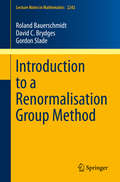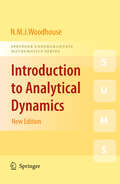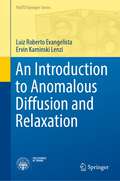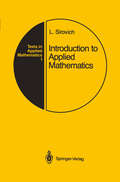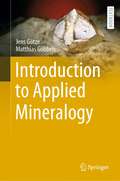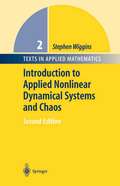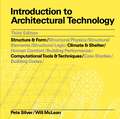- Table View
- List View
Introduction to 3D Data: Modeling with ArcGIS 3D Analyst and Google Earth
by Heather KennedyRender three-dimensional data and maps with ease. Written as a self-study workbook, Introduction to 3D Data demystifies the sometimes confusing controls and procedures required for 3D modeling using software packages such as ArcGIS 3D Analyst and Google Earth. Going beyond the manual that comes with the software, this profusely illustrated guide explains how to use ESRI’s ArcGIS 3D Analyst to model and analyze three-dimensional geographical surfaces, create 3D data, and produce displays ranging from topographically realistic maps to 3D scenes and spherical earth-like views. The engagingly user-friendly instruction: • Walks you through basic concepts of 3D data, progressing to more advanced techniques such as calculating surface area and volume • Introduces you to two major software packages: ArcGIS 3D Analyst (including ArcScene and ArcGlobe) and Google Earth • Reinforces your understanding through in-depth discussions with over thirty hands-on exercises and tutorial datasets on the support website at www.wiley/college/kennedy • Helps you apply the theory with real-world applications Whether you’re a student or professional in geology, landscape architecture, transportation system planning, hydrology, or a related field, Introduction to 3D Data will quickly turn you into a power user of 3D GIS.
Introduction to a Renormalisation Group Method (Lecture Notes in Mathematics #2242)
by Roland Bauerschmidt David C. Brydges Gordon SladeThis is a primer on a mathematically rigorous renormalisation group theory, presenting mathematical techniques fundamental to renormalisation group analysis such as Gaussian integration, perturbative renormalisation and the stable manifold theorem. It also provides an overview of fundamental models in statistical mechanics with critical behaviour, including the Ising and φ4 models and the self-avoiding walk. The book begins with critical behaviour and its basic discussion in statistical mechanics models, and subsequently explores perturbative and non-perturbative analysis in the renormalisation group. Lastly it discusses the relation of these topics to the self-avoiding walk and supersymmetry. Including exercises in each chapter to help readers deepen their understanding, it is a valuable resource for mathematicians and mathematical physicists wanting to learn renormalisation group theory.
Introduction to Aerosol Modelling: From Theory to Code
by David ToppingINTRODUCTION TO AEROSOL MODELLING Introduction to Aerosol Modelling: From Theory to Code An aerosol particle is defined as a solid or liquid particle suspended in a carrier gas. Whilst we often treat scientific challenges in a siloed way, aerosol particles are of interest across many disciplines. For example, atmospheric aerosol particles are key determinants of air quality and climate change. Knowledge of aerosol physics and generation mechanisms is key to efficient fuel delivery and drug delivery to the lungs. Likewise, various manufacturing processes require optimal generation, delivery and removal of aerosol particles in a range of conditions. There is a natural tendency for the aerosol scientist to therefore work at the interface of the traditional academic subjects of physics, chemistry, biology, mathematics and computing. The impacts that aerosol particles have are linked to their evolving chemical and physical characteristics. Likewise, the chemical and physical characteristic of aerosol particles reflect their sources and subsequent processes they have been subject to. Computational models are not only essential for constructing evidence-based understanding of important aerosol processes, but also to predict change and impact. Whilst existing textbooks provide an overview of theoretical frameworks on which aerosol models are based, there is a significant gap in reference material that provide training in translating theory into code. The purpose of this book is to provide readers with exactly that. In following the content provided in this book, you will be able to reproduce models of key processes that can either be used in isolation or brought together to construct a demonstrator 0D box-model of a coupled gaseous-particulate system. You may be reading this book as an undergraduate, postgraduate, seasoned researcher in the private/public sector or as someone who wishes to better understand the pathways to aerosol model development. Wherever you position yourself, it is hoped that the tools you will learn through this book will provide you with the basis to develop your own platforms and to ensure the next generation of aerosol modellers are equipped with foundational skills to address future challenges in aerosol science.
Introduction to Aerosol Modelling: From Theory to Code
by David L. Topping Michael BaneINTRODUCTION TO AEROSOL MODELLING Introduction to Aerosol Modelling: From Theory to Code An aerosol particle is defined as a solid or liquid particle suspended in a carrier gas. Whilst we often treat scientific challenges in a siloed way, aerosol particles are of interest across many disciplines. For example, atmospheric aerosol particles are key determinants of air quality and climate change. Knowledge of aerosol physics and generation mechanisms is key to efficient fuel delivery and drug delivery to the lungs. Likewise, various manufacturing processes require optimal generation, delivery and removal of aerosol particles in a range of conditions. There is a natural tendency for the aerosol scientist to therefore work at the interface of the traditional academic subjects of physics, chemistry, biology, mathematics and computing. The impacts that aerosol particles have are linked to their evolving chemical and physical characteristics. Likewise, the chemical and physical characteristic of aerosol particles reflect their sources and subsequent processes they have been subject to. Computational models are not only essential for constructing evidence-based understanding of important aerosol processes, but also to predict change and impact. Whilst existing textbooks provide an overview of theoretical frameworks on which aerosol models are based, there is a significant gap in reference material that provide training in translating theory into code. The purpose of this book is to provide readers with exactly that. In following the content provided in this book, you will be able to reproduce models of key processes that can either be used in isolation or brought together to construct a demonstrator 0D box-model of a coupled gaseous-particulate system. You may be reading this book as an undergraduate, postgraduate, seasoned researcher in the private/public sector or as someone who wishes to better understand the pathways to aerosol model development. Wherever you position yourself, it is hoped that the tools you will learn through this book will provide you with the basis to develop your own platforms and to ensure the next generation of aerosol modellers are equipped with foundational skills to address future challenges in aerosol science.
An Introduction to Agricultural Geography
by David GriggEmploying nearly half of the world's workforce, agriculture is clearly of great economic and social importance. An incredible variety of methods are used globally; the Western world has the latest scientific and industrial advancements at its disposal, yet in the Thrid World a living is made using tools that have hardly changed in two thousand years. An Introduction to Agricultural Geography provides an extensive guide through this diverse and increaslingly important geographical subject, aiming to show that a wide range of factors explain how agricultural practices differ from place to place. Dealing with the physical environment, economic behaviour and demands, institutional and social influences and the impact of farming upon the environment, the author has produced an important introductory text that is topical, incisive and ultimately essential to reach an understanding of the remarkable diversity of the world's major industry.
An Introduction to Agricultural Geography
by David GriggEmploying nearly half of the world's workforce, agriculture is clearly of great economic and social importance. An incredible variety of methods are used globally; the Western world has the latest scientific and industrial advancements at its disposal, yet in the Thrid World a living is made using tools that have hardly changed in two thousand years. An Introduction to Agricultural Geography provides an extensive guide through this diverse and increaslingly important geographical subject, aiming to show that a wide range of factors explain how agricultural practices differ from place to place. Dealing with the physical environment, economic behaviour and demands, institutional and social influences and the impact of farming upon the environment, the author has produced an important introductory text that is topical, incisive and ultimately essential to reach an understanding of the remarkable diversity of the world's major industry.
Introduction to Algebraic Quantum Field Theory (Mathematics and its Applications #19)
by S.S. HoruzhyAn Introduction to Analysis on Wiener Space (Lecture Notes in Mathematics #1610)
by Ali S. ÜstünelThis book gives the basis of the probabilistic functional analysis on Wiener space, developed during the last decade. The subject has progressed considerably in recent years thr- ough its links with QFT and the impact of Stochastic Calcu- lus of Variations of P. Malliavin. Although the latter deals essentially with the regularity of the laws of random varia- bles defined on the Wiener space, the book focuses on quite different subjects, i.e. independence, Ramer's theorem, etc. First year graduate level in functional analysis and theory of stochastic processes is required (stochastic integration with respect to Brownian motion, Ito formula etc). It can be taught as a 1-semester course as it is, or in 2 semesters adding preliminaries from the theory of stochastic processes It is a user-friendly introduction to Malliavin calculus!
Introduction to Analytical Dynamics (Springer Undergraduate Mathematics Series)
by Nicholas WoodhouseFirst published in 1987, this text offers concise but clear explanations and derivations to give readers a confident grasp of the chain of argument that leads from Newton’s laws through Lagrange’s equations and Hamilton’s principle, to Hamilton’s equations and canonical transformations. This new edition has been extensively revised and updated to include: A chapter on symplectic geometry and the geometric interpretation of some of the coordinate calculations. A more systematic treatment of the conections with the phase-plane analysis of ODEs; and an improved treatment of Euler angles. A greater emphasis on the links to special relativity and quantum theory showing how ideas from this classical subject link into contemporary areas of mathematics and theoretical physics. A wealth of examples show the subject in action and a range of exercises – with solutions – are provided to help test understanding.
Introduction to Analytical Methods in Organic Geochemistry (Fundamentals in Organic Geochemistry)
by Jan Schwarzbauer Branimir JovančićevićAll sub disciplines in Organic Geochemistry (Petroleum Geochemistry, Environmental Geochemistry etc.) are linked by the basic analytical approaches used for identification and quantitation of individual organic substances. Hence, a fundamental prerequisite for organic geochemists is the knowledge not only about the individual analytical techniques but more about their potential as well as their limitations. In this issues basic analytical procedures and techniques are introduced comprising fundamental steps like sampling and sample storage, aspects of sample treatment like extraction and fractionation procedures and finally the specific techniques used for organic analyses on partially very low concentration levels such as mass spectrometry or infrared spectroscopy. Beside the technical aspects also application on organic-geochemical problems and the standard data evaluation practice is introduced. Finally, special chapters point to analytical pitfalls and to principal standard operation procedures. The intention of this issue is to get the readers familiar with analytical Organic Geochemistry and to enable them to assess the quality and suitability of specific analytical approaches, in particular with respect to the organic-geochemical problems.
An Introduction to Anomalous Diffusion and Relaxation (PoliTO Springer Series)
by Luiz Roberto Evangelista Ervin Kaminski LenziThis book provides a contemporary treatment of the problems related to anomalous diffusion and anomalous relaxation. It collects and promotes unprecedented applications dealing with diffusion problems and surface effects, adsorption-desorption phenomena, memory effects, reaction-diffusion equations, and relaxation in constrained structures of classical and quantum processes. The topics covered by the book are of current interest and comprehensive range, including concepts in diffusion and stochastic physics, random walks, and elements of fractional calculus. They are accompanied by a detailed exposition of the mathematical techniques intended to serve the reader as a tool to handle modern boundary value problems. This self-contained text can be used as a reference source for graduates and researchers working in applied mathematics, physics of complex systems and fluids, condensed matter physics, statistical physics, chemistry, chemical and electrical engineering, biology, and many others.
An Introduction to Applied and Environmental Geophysics
by John M. ReynoldsAn Introduction to Applied and Environmental Geophysics, 2nd Edition, describes the rapidly developing field of near-surface geophysics. The book covers a range of applications including mineral, hydrocarbon and groundwater exploration, and emphasises the use of geophysics in civil engineering and in environmental investigations. Following on from the international popularity of the first edition, this new, revised, and much expanded edition contains additional case histories, and descriptions of geophysical techniques not previously included in such textbooks. The level of mathematics and physics is deliberately kept to a minimum but is described qualitatively within the text. Relevant mathematical expressions are separated into boxes to supplement the text. The book is profusely illustrated with many figures, photographs and line drawings, many never previously published. Key source literature is provided in an extensive reference section; a list of web addresses for key organisations is also given in an appendix as a valuable additional resource. Covers new techniques such as Magnetic Resonance Sounding, Controlled- Source EM, shear-wave seismic refraction, and airborne gravity and EM techniques Now includes radioactivity surveying and more discussions of down-hole geophysical methods; hydrographic and Sub-Bottom Profiling surveying; and UneXploded Ordnance detection Expanded to include more forensic, archaeological, glaciological, agricultural and bio-geophysical applications Includes more information on physio-chemical properties of geological, engineering and environmental materials Takes a fully global approach Companion website with additional resources available at www.wiley.com/go/reynolds/introduction2e Accessible core textbook for undergraduates as well as an ideal reference for industry professionals The second edition is ideal for students wanting a broad introduction to the subject and is also designed for practising civil and geotechnical engineers, geologists, archaeologists and environmental scientists who need an overview of modern geophysical methods relevant to their discipline. While the first edition was the first textbook to provide such a comprehensive coverage of environmental geophysics, the second edition is even more far ranging in terms of techniques, applications and case histories.
An Introduction to Applied and Environmental Geophysics
by John M. ReynoldsAn Introduction to Applied and Environmental Geophysics, 2nd Edition, describes the rapidly developing field of near-surface geophysics. The book covers a range of applications including mineral, hydrocarbon and groundwater exploration, and emphasises the use of geophysics in civil engineering and in environmental investigations. Following on from the international popularity of the first edition, this new, revised, and much expanded edition contains additional case histories, and descriptions of geophysical techniques not previously included in such textbooks. The level of mathematics and physics is deliberately kept to a minimum but is described qualitatively within the text. Relevant mathematical expressions are separated into boxes to supplement the text. The book is profusely illustrated with many figures, photographs and line drawings, many never previously published. Key source literature is provided in an extensive reference section; a list of web addresses for key organisations is also given in an appendix as a valuable additional resource. Covers new techniques such as Magnetic Resonance Sounding, Controlled- Source EM, shear-wave seismic refraction, and airborne gravity and EM techniques Now includes radioactivity surveying and more discussions of down-hole geophysical methods; hydrographic and Sub-Bottom Profiling surveying; and UneXploded Ordnance detection Expanded to include more forensic, archaeological, glaciological, agricultural and bio-geophysical applications Includes more information on physio-chemical properties of geological, engineering and environmental materials Takes a fully global approach Companion website with additional resources available at www.wiley.com/go/reynolds/introduction2e Accessible core textbook for undergraduates as well as an ideal reference for industry professionals The second edition is ideal for students wanting a broad introduction to the subject and is also designed for practising civil and geotechnical engineers, geologists, archaeologists and environmental scientists who need an overview of modern geophysical methods relevant to their discipline. While the first edition was the first textbook to provide such a comprehensive coverage of environmental geophysics, the second edition is even more far ranging in terms of techniques, applications and case histories.
Introduction to Applied Mathematics (Texts in Applied Mathematics #1)
by Lawrence SirovichFrom the Preface: "The material in this book is based on notes for a course which I gave several times at Brown University. The target of the course was juniors and seniors majoring in applied mathematics, engineering and other sciences. My basic goal in the course was to teach standard methods, or what I regard as a basic "bag of tricks". In my opinion the material contained here, for the most part, does not depart widely from traditional subject matter. One such departure is the discussion of discrete linear systems. Besides being interesting in its own right, this topic is included because the treatment of such systems leads naturally to the use of discrete Fourier series, discrete Fourier transforms, and their extension, the Z-transform. On making the transition to continuous systems we derive their continuous analogues, viz., Fourier series, Fourier transforms, Fourier integrals and Laplace transforms. A main advantage to the approach taken is that a wide variety of techniques are seen to result from one or two very simple but central ideas. Above all, this course is intended as being one which gives the student a "can-do" frame of mind about mathematics. Students should be given confidence in using mathematics and not be made fearful of it. I have, therefore, forgone the theorem-proof format for a more informal style. Finally, a concerted effort was made to present an assortment of examples from diverse applications with the hope of attracting the interest of the student, and an equally dedicated effort was made to be kind to the reader."
Introduction to Applied Mineralogy
by Jens Götze Matthias GöbbelsThis textbook teaches important material and technological fundamentals in various technical systems and applied geoscientific fields. Beginning with the mineralogical characteristics of selected non-metallic raw materials and industrial minerals, this book presents the connections between properties and industrial applications and discusses the environment-relevant aspects as well as problems of biomineralogy. An introduction is given to important mineralogical and physico-chemical aspects of ceramic materials such as silicate ceramics, glass, cement, refractory materials as well as an overview about material synthesis.This makes it the first textbook to present the fundamentals of applied mineralogy as a material-related geoscience in a compact form and to show important bridges to industrial issues and approaches to solutions. It is aimed primarily at undergraduate students of geosciences and materials science, but is also suitable for related disciplines and practical applications.
Introduction to Applied Nonlinear Dynamical Systems and Chaos (Texts in Applied Mathematics #2)
by Stephen WigginsThis introduction to applied nonlinear dynamics and chaos places emphasis on teaching the techniques and ideas that will enable students to take specific dynamical systems and obtain some quantitative information about their behavior. The new edition has been updated and extended throughout, and contains a detailed glossary of terms. From the reviews: "Will serve as one of the most eminent introductions to the geometric theory of dynamical systems." --Monatshefte für Mathematik
Introduction to Architectural Science: The Basis of Sustainable Design
by Steven V. SzokolayNow in its third edition, this book provides the ideal and only reference to the physical basis of architectural design. Fully updated and expanded throughout, the book provides the data required for architects to design buildings that will maintain the users comfort in a variety of conditions, with minimal reliance on energy intensive methods like air conditioning. This is not a ‘how to’ book but answers the question why. It equips the reader with the tools to realize the full potential of the good intentions of sustainable, bioclimatic design. All sections have been revised and updated for this third edition including all the most relevant developments affecting heat, light and sound controls. The book responds to the need of understanding beyond ‘rules of thumb’.
Introduction to Architectural Science: The Basis of Sustainable Design
by Steven V. SzokolayNow in its third edition, this book provides the ideal and only reference to the physical basis of architectural design. Fully updated and expanded throughout, the book provides the data required for architects to design buildings that will maintain the users comfort in a variety of conditions, with minimal reliance on energy intensive methods like air conditioning. This is not a ‘how to’ book but answers the question why. It equips the reader with the tools to realize the full potential of the good intentions of sustainable, bioclimatic design. All sections have been revised and updated for this third edition including all the most relevant developments affecting heat, light and sound controls. The book responds to the need of understanding beyond ‘rules of thumb’.
Introduction to Architectural Technology Third Edition
by Pete Silver William McLeanUnderstanding the relationship between design and technology is critical to the understanding of architecture. This book clearly explains the core aspects of architectural technology: structural physics, structural elements and forms, heating, lighting, environmental control and computer modelling. The third edition includes six new case studies, more on structural types, new information on construction detailing, passive building principles and designing for different climatic conditions. This essential introduction to architecture will help students to integrate their design thinking with the appropriate structural and environmental solutions.
Introduction to Arnold’s Proof of the Kolmogorov–Arnold–Moser Theorem
by Achim FeldmeierThis book provides an accessible step-by-step account of Arnold’s classical proof of the Kolmogorov–Arnold–Moser (KAM) Theorem. It begins with a general background of the theorem and proves the famous Liouville-Arnold theorem for integrable systems and introduces Kneser’s tori in four-dimensional phase space. It then introduces and discusses the ideas and techniques used in Arnold’s proof, before the second half of the book walks the reader through a detailed account of Arnold’s proof with all the required steps. It will be a useful guide for advanced students of mathematical physics, in addition to researchers and professionals. Key features: Applies concepts and theorems from real and complex analysis (e.g. Fourier series; implicit function theorem) and topology in the framework of this key theorem from mathematical physics. Covers all aspects of Arnold’s proof, including those often left out in more general or simplified presentations. Discusses, in detail, the ideas used in the proof of the KAM theorem and puts them in historical context (e.g. mapping degree from algebraic topology).
Introduction to Arnold’s Proof of the Kolmogorov–Arnold–Moser Theorem
by Achim FeldmeierThis book provides an accessible step-by-step account of Arnold’s classical proof of the Kolmogorov–Arnold–Moser (KAM) Theorem. It begins with a general background of the theorem and proves the famous Liouville-Arnold theorem for integrable systems and introduces Kneser’s tori in four-dimensional phase space. It then introduces and discusses the ideas and techniques used in Arnold’s proof, before the second half of the book walks the reader through a detailed account of Arnold’s proof with all the required steps. It will be a useful guide for advanced students of mathematical physics, in addition to researchers and professionals. Key features: Applies concepts and theorems from real and complex analysis (e.g. Fourier series; implicit function theorem) and topology in the framework of this key theorem from mathematical physics. Covers all aspects of Arnold’s proof, including those often left out in more general or simplified presentations. Discusses, in detail, the ideas used in the proof of the KAM theorem and puts them in historical context (e.g. mapping degree from algebraic topology).
Introduction to Astrochemistry: Chemical Evolution from Interstellar Clouds to Star and Planet Formation (Astronomy and Astrophysics Library #7)
by Satoshi YamamotoThis important book describes the basic principles of astrochemistry—an interdisciplinary field combining astronomy, physics, and chemistry—with particular emphasis on its physical and chemical background. Chemical processes in diffuse clouds, dense quiescent molecular clouds, star-forming regions, and protoplanetary disks are discussed. A brief introduction to molecular spectroscopy and observational techniques is also presented. These contents provide astronomers with a comprehensive understanding of how interstellar matter is evolved and brought into stars and planets, which is ultimately related to the origin of the solar system. The subject matter will also be understandable and useful for physical chemists who are interested in exotic chemical processes occurring in extreme physical conditions. The book is a valuable resource for all researchers beginning at the graduate level.
Introduction to Atmospheric Chemistry
by Daniel JacobAtmospheric chemistry is one of the fastest growing fields in the earth sciences. Until now, however, there has been no book designed to help students capture the essence of the subject in a brief course of study. Daniel Jacob, a leading researcher and teacher in the field, addresses that problem by presenting the first textbook on atmospheric chemistry for a one-semester course. Based on the approach he developed in his class at Harvard, Jacob introduces students in clear and concise chapters to the fundamentals as well as the latest ideas and findings in the field. Jacob's aim is to show students how to use basic principles of physics and chemistry to describe a complex system such as the atmosphere. He also seeks to give students an overview of the current state of research and the work that led to this point. Jacob begins with atmospheric structure, design of simple models, atmospheric transport, and the continuity equation, and continues with geochemical cycles, the greenhouse effect, aerosols, stratospheric ozone, the oxidizing power of the atmosphere, smog, and acid rain. Each chapter concludes with a problem set based on recent scientific literature. This is a novel approach to problem-set writing, and one that successfully introduces students to the prevailing issues. This is a major contribution to a growing area of study and will be welcomed enthusiastically by students and teachers alike.
Introduction to Atmospheric Chemistry
by Daniel JacobAtmospheric chemistry is one of the fastest growing fields in the earth sciences. Until now, however, there has been no book designed to help students capture the essence of the subject in a brief course of study. Daniel Jacob, a leading researcher and teacher in the field, addresses that problem by presenting the first textbook on atmospheric chemistry for a one-semester course. Based on the approach he developed in his class at Harvard, Jacob introduces students in clear and concise chapters to the fundamentals as well as the latest ideas and findings in the field. Jacob's aim is to show students how to use basic principles of physics and chemistry to describe a complex system such as the atmosphere. He also seeks to give students an overview of the current state of research and the work that led to this point. Jacob begins with atmospheric structure, design of simple models, atmospheric transport, and the continuity equation, and continues with geochemical cycles, the greenhouse effect, aerosols, stratospheric ozone, the oxidizing power of the atmosphere, smog, and acid rain. Each chapter concludes with a problem set based on recent scientific literature. This is a novel approach to problem-set writing, and one that successfully introduces students to the prevailing issues. This is a major contribution to a growing area of study and will be welcomed enthusiastically by students and teachers alike.
An Introduction to Banach Space Theory (Graduate Texts in Mathematics #183)
by Robert E. MegginsonPreparing students for further study of both the classical works and current research, this is an accessible text for students who have had a course in real and complex analysis and understand the basic properties of L p spaces. It is sprinkled liberally with examples, historical notes, citations, and original sources, and over 450 exercises provide practice in the use of the results developed in the text through supplementary examples and counterexamples.

